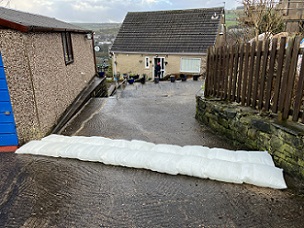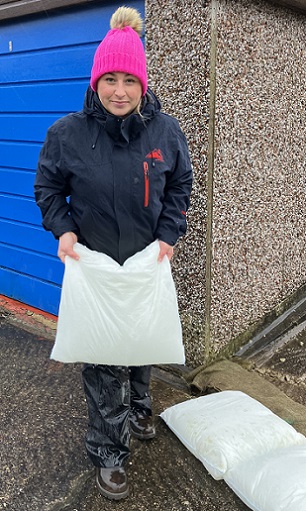 Homes could be at risk of flooding from artificial grass. Image by Harry Strauss from Pixabay.
Homes could be at risk of flooding from artificial grass. Image by Harry Strauss from Pixabay.
 FloodSax alternative sandbags protecting a house from water running down a driveway
FloodSax alternative sandbags protecting a house from water running down a driveway
 Lucy Bailey deploying FloodSax to protect a house from flash flooding
Lucy Bailey deploying FloodSax to protect a house from flash flooding
How artificial grass is artificially unintelligent when it comes to preventing flooding
Getting rid of natural grass lawns and replacing them with artificial grass is something of a fad these days.
But it may be putting homes, businesses and even large buildings such as schools and hospitals at a greater risk of flooding.
Scientists say artificial grass only soaks up around 50% of the amount of water that would usually vanish into lawns.
This, coupled with driveways and more paved areas, is likely to send rainwater cascading towards doors, cellars and basements during torrential rain.
A study by Kings College in London discovered that although natural lawns can absorb most rainfall, artificial surfaces allowed over 50% of the equivalent amount to remain on the surface.
Longer and more densely packed artificial grass fared even worse in the tests and none came close to matching the same absorption of the natural stuff.
It’s all part of what’s known as urban creep with gardens vanishing beneath concrete, tarmac and paving slabs as people look to park their vehicles off road and cut down on gardening.
There has been a move for people to ‘dig up their drives,’ and replace them with grass especially in cities such as London to try to prevent flash flooding wrecking property, especially basement flats.
But Lucy Bailey from alternative sandbag company FloodSax doesn’t think it will happen.
“Once people have paved over their gardens to create a drive for off-road parking they will never go back to a lawn and flower beds again,” she said. “When this grass and soil have gone they’ll have gone for good.
“What many people don’t realise is just how much water natural grass and soil soaks up, especially during torrential rain and flash floods. Where once a house had no flooding problem, after it’s tarmacked or paved over the water has nowhere to go, especially if the drains are already struggling to cope during a flash flood.
“We’ve seen it happen many times where the water has gone straight down a driveway and into a house or garage, wrecking everything inside and causing thousands of pounds of water damage, not to mention the hassle of sorting it out and the misery of even having to move out for months while expensive repairs are done.”
Yet a box of 20 FloodSax which retails for around £140 can save all this. They are vacuum-packed so are space-saving to store yet can be quick to deploy in a flooding emergency. Simply immerse a FloodSax in water and its gelling polymer absorbs and retains around 20 litres to become an instant sandless sandbag. The FloodSax’s uniform shape means it’s easy to build into temporary wall-style flood barriers to protect doors and air bricks.
FloodSax are multi-purpose as in their dry state they are very thin with a large surface area so can soak up spills, leaks and floods in hard-to-reach places such as beneath pipes and under sinks or boilers.
According to insurance giant Aviva, a quarter of homeowners with outside space have turned some of their garden into a driveway and one in 10 have replaced their garden’s natural lawn with artificial grass. Around a third admit it’s simply down to laziness as they don’t want to be bothered keeping up to a lawn or doing any gardening.
Another reason is the lack of parking space on roads and the growth of parking permits costing people more and more every year.
This is all happening even though 57% of people realise that making such changes will have an impact on the environment and at a time when one in five homes in the UK is at risk from surface water or flash flooding.
Hannah Davidson, senior home insurance underwriter at Aviva UK General Insurance, said: “Flash flooding is harder to predict than flooding from rivers or streams and can happen anywhere and at any time. This looks set to rise as climate change impacts the UK, causing an increased risk from localised torrential downpours.
“As we witnessed with London’s flash floods in recent summers, urban areas are most at risk because a lack of green space can leave rainwater with nowhere to go when the drains are overwhelmed. The impacts of flash floods shouldn’t be under-estimated either. Even a few centimetres of rainwater can have a devastating impact on homes, taking weeks or months to dry out and many belongings may have to be thrown away.”
For more information on FloodSax and how to buy them online go to www.floodsax.co.uk